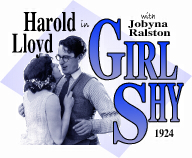

The Harold Lloyd Corporation - Pathé Exchange
Cast: Harold Lloyd (Harold Meadows), Jobyna Ralston (Mary Buckingham), Richard Daniels (Jerry Meadows), Carlton Griffin (Ronald DeVore)
"Girl Shy" is a great movie, but, unfortunately, the imaginative gags and endearing love story seem to be forgotten in favor the final chase sequence.
Adam Reilly (Harold Lloyd: The King of Daredevil Comedy, MacMillan Publishing Co., Inc., 1977) said, "'Girl Shy' contains . . . one of his most exciting race sequences. And yet, the overall film is not as satisfying as perhaps it could be."
The forever acerbic Richard Schickel (Harold Lloyd: The Shape of Laughter, The New York Graphic Society, 1974) said, "It contains one of Lloyd's greatest sequences, but like so many of his pictures, the several reels it required to reach this marvelously perilous gag island were not more than mediocre."
Unfortunately, Lloyd himself seemed to only be able to focus on the final chase sequence. Referring to "Girl Shy," he said, "I don't think that was as good as the two that I've mentioned ('The Freshman' and 'The Kid Brother'), but it has probably one of the best sequences that we've ever made." (The Silent Picture, Summer-Autumn, 1971)
As an indication of how all but the chase has apparently been erased in viewer's memories, An erroneous statement by Walter Kerr in his much revered book, The Silent Clowns (Alfred A. Knopf, 1975), is indicative of how the movie is remembered by most. He said, "'Girl Shy,' for instance, is virtually one long chase." Apparently Kerr's memory failed him. Although the chase is a lengthy one, it comprises about 21 minutes of an 80 minutes film. The remaining 59 minutes of the film, which are a masterful blending of romance, story construction and humor, seemingly were all but erased from Kerr's memory because of the movie's rousing climax.
Granddaughter Suzanne Lloyd and co-author Jeffrey Vance
in Harold Lloyd: Master Comedian (Harry N. Abrams, Inc.,
2002) noted that "Lloyd was justifiably proud of the elaborate
and brilliantly executed chase," adding, "Harold felt
uncomfortable about his stutter character in later years, and
believed the chase sequence - which he loved - overwhelmed everything
that preceded it," and, it appears there may be some credence
to his observation when one considers the attention that has been
given to the 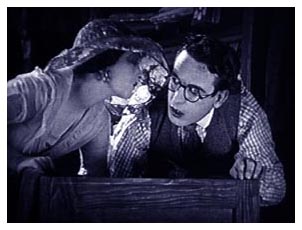 chase sequence in
the ensuing years.
chase sequence in
the ensuing years.
However, there is one reason why so much praise has been heaped on the chase/race sequence while the rest of the film escapes most writers' memories. Lloyd owned the rights to all of his feature films and kept them out of circulation for fear they would be "mutiliated" like so many silent films were for TV showing (for example, the "Fractured Flickers" that basically poked fun at silent movies by adding corny dialogue that had nothing to do with the story). However, he did release a compilation film in 1962 entitled, "Harold Lloyd's World of Comedy" which used the chase/race sequence from "Girl Shy" almost in its entirety. For several decades, this was all that most of the public ever saw of "Girl Shy," so it's no wonder the rest of the film is quite often dismissed in favor of the brilliant closing sequence.
Lloyd and Vance go on to say, though, "Modern viewers do not share Harold's reservations. 'Girl Shy' contains some wonderful comedy, a well-developed and moving relationship between Harold and leading lady Jobyna Ralston, and the precision pacing of the very best Lloyd features."
Bingo! This is the kind of assessment that most accurately describes this wonderful movie!
"Girl Shy" proves that Lloyd was a "complete" filmmaker. Yes, he knew how to do a chase - one of the best ever put on film - and he knew how to thrill an audience - a skill that somewhat annoyed him in later years because his films were often referred to generically as "thrill pictures," when, in fact, the "thrill pictures" constituted only a handful of his total cinematic output. But Lloyd also knew how to build a story, develop characters (an exceptional ability for which he never seems to get credit), engage the audience, elicit sympathy (not pity!), make the viewer's heart pound with excitement, create beauty (in settings and story line), and build a climax that leaves the viewer satisfied and completely drained!
"Girl Shy" and "The Kid Brother" (1927) are Lloyd's two "beautiful" films, both with tender story lines, a well-constructed love interest, and final reels that are jam-packed with excitement. Quite often, "The Kid Brother" gets more attention, but, allowing for differences in tastes, "Girl Shy" is just as good.
Although it was noted that Lloyd felt uncomfortable in later years with the stuttering character of Harold Meadows in "Girl Shy," the stuttering fits the character well. Harold is a tailor's apprentice whose shyness around girls is somewhat extreme, to say the least. This "affliction" supports the shyness in a visual manner that makes it well-suited for a silent film. It also enhances the comedic element making his ineptness all the more believable (for example, when he absent-mindedly eats a piece of cheese from a mouse trap while two flirtatious young girls are in the shop). Besides, when his confidence is built up, the stuttering disappears - a smart move on Lloyd's part so that the stuttering angle is not overplayed. For instance, when he meets Mary (Jobyna Ralston) on the train, he has no trouble talking to her as long as he's talking about his book - something that he has a passion for and feels comfortable talking about - a believable cure for his stuttering.
Speaking of the sequence on the train, this is a most enjoyable, inventive and hilarious way for the two young people to meet. The sequence revolves around how Harold uses his ingenuity to keep the conductor from discovering that Mary's dog is on board. At one point, he hides the dog inside his valise, but mistakenly puts the animal in a lady's valise that is identical to his. Of course, he has to stuff several articles of clothing in his pockets to make room for the dog -- not realizing that these articles of clothing are ladies' undergarments! The embarrassment expressed by Harold when the lady angrily removes her clothing from his pockets is priceless! Keep in mind, this is a guy who is terrified of females to begin with, and it's all happening in front of the girl he's trying to impress!
Lloyd's acting skill must also be noted at this point. When the conductor notices the box of dog biscuits, Harold must pretend they are his, and that requires eating one of them! The forced smile while chewing on the repulsive dog food is a fine piece of acting. The New York Times (April 21, 1924) reviewer apparently appreciated this, as well. "There is much to provoke laughter in this picture, especially the grimaces of the indefatigable Mr. Lloyd, when he is in embarrassing situations, as he is most of the time." Again, Lloyd has provided us with some of the finest comedy you'll find from the comedy-rich silent era.
But he also provides us with some of the best romance that
you'll find in any film - silent or sound era. The train ride
has ended. Harold escorts Mary to her cab. As he 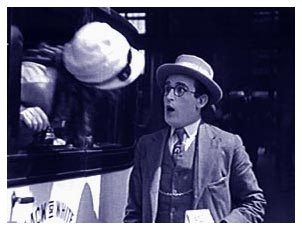 shuffles
embarrassingly trying to figure out what parting words he should
say, she leans out of the cab window, gives him a quick kiss,
and the cab speeds off before he has time to react. He is stunned,
and stumbles after the cab right into the middle of a busy intersection.
The scene fades with Harold sitting in the middle of the traffic,
staring glassy-eyed at the departing cab, and, with dog biscuit
box still in hand, he dumbly pulls one out and begins eating it.
shuffles
embarrassingly trying to figure out what parting words he should
say, she leans out of the cab window, gives him a quick kiss,
and the cab speeds off before he has time to react. He is stunned,
and stumbles after the cab right into the middle of a busy intersection.
The scene fades with Harold sitting in the middle of the traffic,
staring glassy-eyed at the departing cab, and, with dog biscuit
box still in hand, he dumbly pulls one out and begins eating it.
The box of dog biscuits and a box of Cracker Jack that Harold bought Mary on the train provide a very nice touch to the romance, as well. Harold cherishes the empty box of dog biscuits as a reminder of this wonderful girl that he'll probably never meet again, and Mary keeps her empty box of Cracker Jack with her always to remember the sweet boy she met on the train. These two props are used ingeniously later in the film to reveal the affection the two have for each other.
Later we see Mary and suitor Ronald DeVore (more will be said about him later) motoring through the country, a trip that they apparently have taken several times. Each time, though, Mary insists on taking the long way home through Little Bend. Ronald can't understand why, but the viewer knows why she does it - this is where Harold lives. On one of these excursions, Ronald's aggressive overtures cause Mary to drive the car in a ditch. When Ronald leaves to get a tow truck, Mary decides to take a walk. We then see a beautiful scene, framed in soft focus, of Mary walking across an arched bridge over a stream in a lovely, rural, idyllic setting and stopping to look down at the water. Harold, who has been caressing the dog biscuit box and dreaming about Mary, is in a rowboat underneath the bridge. He looks down at the water and sees her face there - not realizing this is her actual reflection as she looks down at the water from above - a beautifully poignant scene.
Obviously, intertitles can make or break a film, but Lloyd's films contain some of the best - not corny jokes or "flowery" language - but well-written verbage that that don't compete with the visual humor and that set the tone for each scene with precision. For example, the title that introduces us to Harold's bucolic reverie as he sits in the little rowboat in the stream, caressing his dog biscuit box, is charming in its simplicity. "Sunday - Long weeks came and went - you couldn't stop them. Short dreams came - and, well - who wants to stop them?"
The two finally discover each other in this idyllic setting and spend a delightful time together - Mary listening intently as Harold tells her more about his book. He says he will be going to the publisher on Tuesday to find out what they think of his manuscript, and the two agree to meet that day.
Harold goes to the publisher's on Tuesday, and is devastated when his manuscript is rejected. To add insult to injury, the girls in the office have read his book and laughed at it - one even exclaiming that she wanted to meet the "sheik" who wrote this. As he walks through the outer office toward the door, the girls tease him, tug at him, kiss him and even cut a lock of his hair. It is a sadly poignant scene.
He goes across the street to the park just as Mary drives
up. She sees him and runs to meet him. Dejected at his failure
and feeling that without money from the publication of his book
he can't propose to her, he tells her their romance was a pretense
- he was only doing research for his book. Lloyd's acting during
this scene is superb as he obviously tries to hold back the tears
and forces a laugh while "sparing" Mary from his failure.
As a lowly tailor's apprentice, he feels he now has nothing to
offer her. "Why - why, you didn't believe all I said, did
you?" he says while trying to force a smile, and Mary replies,
"I'm afraid I did." When a girl comes by who flirted
with him earlier, he walks off with her as Mary watches tearfully.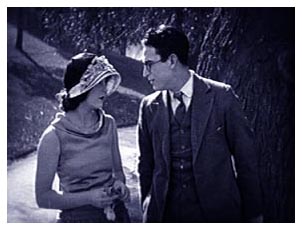
The love story of "Girl Shy," however, as good as it is, couldn't stand alone. Lloyd realized there must be more -- an antagonist -- someone the audience can dislike and enjoy seeing him get his "come-uppance" - and one that poses a threat to Mary so that the hero has an opportunity to rescue her.
As noted before, Lloyd knew how to develop characters, and he realized that if Ronald DeVore is to be the villain in this story, his despicable character must be established early on. This is made evident in the very first scene in which Ronald appears. He arrives at Mary's home, and as he gives the maid his hat, he pauses to caress her hand. With one small gesture, Lloyd has established the kind of person this character is. Since Mary is out, he goes in to meet her mother and shows her a ring. Now we realize he intends to propose to Mary. Within a couple of minutes of film and with two seemingly small gestures, the viewer is drawn even more into the story, whose plot has now begun to "thicken." As if we weren't worried enough about someone of such questionable character pursuing Mary, we later learn that he is already married - and, coincidentally, to a girl who lives in Little Bend! Now, our disgust with this individual is complete!
Little known Carlton Griffin did a commendable job as the reprehensible Ronald DeVore, but supporting acting honors must go to Jobyna Ralston in only her second film with Lloyd. Variety's reviewer praised her saying, "Playing the lead opposite Lloyd is Jobyna Ralston, who proves herself considerable of an actress in addition to being decidedly pretty."
Most historians and fans agree that Jobyna was Lloyd's best leading lady in his feature films (Bebe Daniels still holds the hearts of most silent movie fans from his early shorts). However, having seen Jobyna in some of her early Hal Roach one and two-reelers (she co-starred with Paul Parrott in several), she could have also been a great asset to his short comedies. Nevertheless, she is perfect for "Girl Shy," beautiful enough that we can understand why he is enamored with her, shy enough herself that the interplay between the two is charming, and an accomplished-enough actress that we also hurt with her when Harold tells her in the park that he was only pretending with her. The final scene is a particularly enjoyable one in which to watch her. After he rescues her from a marriage to a potential bigamist, she reminds Harold that there is a question he was going to ask her - at the same time grasping his coat lapels, moving closer to his face, and dreamily "batting" her eyes. (Credit must be given to Lloyd, too, for appreciating the appeal of Ralston's beauty and acting ability enough to give her close-ups such as this throughout the film.) Of course, he tries to propose, but his stuttering returns, and, no matter how hard he tries, he just can't do it. Mary is frantic and, remembering that the sound of a whistle stops the stuttering, she looks around excitedly for anything that will suffice. Suddenly, she spots a mailman, grabs Harold by the hand, and runs across the street. She desperately begins searching through the astonished mailman's pockets, and ultimately, the whistle is found and blown. When he finally gets the words out, she throws her arms around his neck and kisses him. Jobyna's bounciness, excitement and enthusiasm in a sequence such as this make her a charming and delightful co-star for Lloyd. She made six features with Lloyd, however, it is a shame she didn't stick with him longer.
As noted, "Girl Shy" is a well-constructed story.
However, one part that has received some criticsim is early in
the film when we see Harold in the attic typing the final chapters
of his book. Lloyd lets us see what the book is about with two
sequences that enact individual chapters. In the first one, he
has composed a chapter that suggests "disinterest" as
a way to win the opposite sex. We are then shown a bon vivant
Harold swaggering into the boudoir of a Barbara LaMarr exaggerated
look-alike that Harold wins over by 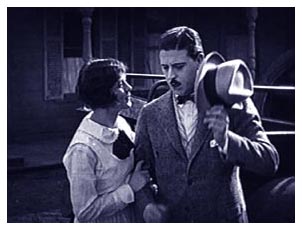 ignoring
her and repelling her pleas and advances. In the second sequence,
he suggests the "cave-man" approach as another means
of winning the fair sex. In this one, his challenge is a flapper
whom he spanks with a shoe and then pushes her so that she falls
back against the wall and plops down on the floor while a shelf
and all its contents crash down on her. Of course, this enamors
her to him, and she covers him with kisses.
ignoring
her and repelling her pleas and advances. In the second sequence,
he suggests the "cave-man" approach as another means
of winning the fair sex. In this one, his challenge is a flapper
whom he spanks with a shoe and then pushes her so that she falls
back against the wall and plops down on the floor while a shelf
and all its contents crash down on her. Of course, this enamors
her to him, and she covers him with kisses.
These two hyperbolic sequences do seem somewhat out of place in the tenor that has been set so far - that of a shy young boy who works in a small town tailor shop and can only dream of going to the town dance to meet a girl. Reilly said, ". . . when Harold visualizes the fantasies of his love life, the realism of the dreams interrupts the mood and tenor of the surrounding material that has been so carefully built up. If the fantasies had been hinted at rather than dramatized, the film might have worked more smoothly." It's not clear how Reilly would have suggested "hinting at" these fantasies, but, although a little awkward in the flow of the story, they do seem somewhat necessary to establish the kind of book Harold has written. Admittedly, the sequences are probably the weakest part of the film, but Lloyd may have felt they were necessary to establish why the girls in the publisher's office would laugh at the book and why the publisher would eventually decide to publish it as "The Boob's Diary." It's difficult to imagine the later events of the story making sense without these sequences to show us how ridiculous his book is.
And, finally, there is the chase sequence, although there's not much that can be said that hasn't already been said. Reilly commented, "The race sequence at the end is definitely Lloyd's most elaborate, matched for excitement only by the finale in 'Speedy,' but here the variety and ingenuity of the vehicles used are incomparable." Variety (April 9, 1924) said, "The last two reels move along so fast, with so many thrills, that the average audience is going to stand up and howl."
Writers have compared it in excitement to Buster Keaton's train chase in "The General" (1927) and the chariot race in "Ben Hur" (1926). It is exciting, and, at the same time, filled with gags. The two modes of transportation that seem to stand out in everyone's memory are the streetcar and the horse-drawn wagon. Burned in anyone's memory who has seen the film is the vision of Harold hanging from the trolley pole after it disconnects from the electric line. Also, the wagon sequence is most memorable for the real-life, unscripted spill that Lloyd took after jumping on the back of one of the two harnessed horses. (Suzanne Lloyd and Vance noted that ". . . in more complicated and dangerous sequences involving horses and the buckboard, a rodeo stunt driver was hired.")
"Girl Shy" took six months to film, cost $400,000 and took in almost $1.73 million. Author Richard Koszarski (An Evening's Entertainment: The Age of the Silent Feature Picture, 1915-1928, University of California Press, 1990) quotes an unpublished study by James Mark Purcell who used box office receipts, exhibitors' reports and other data to rank the most popular pictures of 1922-1927. "Girl Shy" and "Hot Water" (Ralston's third film with Lloyd) tied for fourth place in 1924 outranked only by three super productions: "The Iron Horse," "The Sea Hawk" and "The Thief of Bagdad."
"Girl Shy" was also universally liked by the critics. According to Harrison's Reports (May 3, 1924), "If there should be anywhere a man, woman, or child who would not enjoy this picture thoroughly, then such a one should without delay be examined by a competent physician to determine what is wrong with him. 'Girl Shy' is a riot of good, clean fun. To enumerate all of its humorous situations . . . would require more space than this." The Variety (April 9, 1924) reviewer said, "Harold Lloyd's latest may well be called his best. There is so much action jammed into this picture . . . It's a wow of a comedy picture!"
Copyright © 2005, by Tim Lussier. All rights reserved.